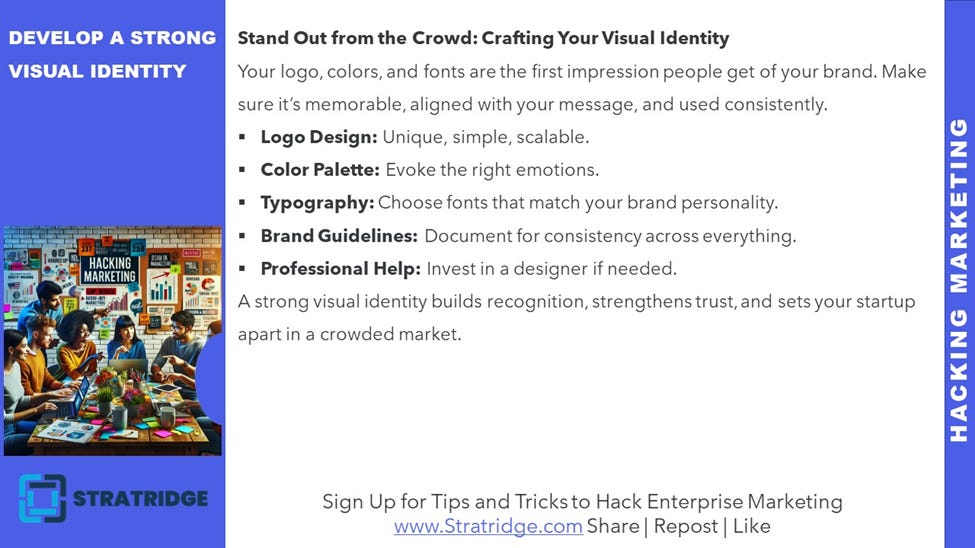In a marketplace flooded with competitors vying for attention, a solid visual identity can be the distinguishing factor that sets a brand apart. More than just a logo or a set of colors, a visual identity encompasses the entire aesthetic presentation of a brand and how it communicates its values and personality to the world.
The Role of Visual Identity in Branding
Visual identity is the visual aspect of branding startups use to communicate with consumers. It helps to shape perceptions and influence emotions, making it a crucial tool for effective marketing. A well-designed visual identity:
Creates a First Impression: Like a book cover, it gives consumers a quick glimpse into what your brand stands for.
Builds Brand Recognition: Consistent use of visual elements makes your brand easily recognizable, enhancing consumer recall.
Supports Marketing Campaigns: A robust visual identity provides a framework for creating cohesive marketing materials that speak directly to target audiences.
Fosters Brand Loyalty: By conveying a brand’s personality and values, a strong visual identity can deepen emotional connections with consumers, fostering loyalty.
Developing a Strong Visual Identity
Logo Design:
Simplicity is Key: A logo should be simple enough to be easily recognizable yet unique enough to be memorable. It should also be versatile and scalable to different sizes without losing clarity.
Relevance: The logo should reflect your brand’s industry and the feelings you want to evoke. It should stand the test of time and not just follow current design trends.
Color Palette:
Psychology of Colors: Different colors evoke different emotions and reactions. Choose a color palette that aligns with the feelings you want associated with your brand. For example, blue can evoke trust and security, while orange might be chosen for its energy and creativity.
Consistency Across Media: Ensure the colors work well online and in print, maintaining consistency across various platforms and marketing materials.
Typography:
Font Selection: Choose fonts that reflect your brand’s personality—professional, friendly, or innovative. Consistency in fonts helps solidify the brand’s voice across all communications.
Readability: Above all, typography should be straightforward to read and functional. This includes considering how text looks on different devices and resolutions.
Developing Brand Guidelines:
Comprehensive Guidelines: Create detailed brand guidelines that dictate how all aspects of the brand’s visual identity are applied. These guidelines should cover logo usage, color palette, typography, imagery, and more.
Guidelines for Different Contexts: Include examples of how to use the visual elements in various contexts, such as digital, print, merchandise, and physical spaces.
Professional Design Help:
Invest in Expertise: Especially for startups without in-house design capabilities, investing in professional design services can ensure that your visual identity is thoughtfully crafted. This can make a significant difference in how your brand is perceived.
Collaboration and Feedback: Work closely with designers, providing clear feedback and ensuring that the final designs align with your brand’s objectives and personality.
Implementing Your Visual Identity
Across All Touchpoints: Ensure your visual identity is consistently applied across all customer touchpoints, from your website and social media to product packaging and physical locations.
Employee Advocacy: Educate your team about the importance of the brand’s visual identity. Employees should understand how to use visual elements properly in their communications and presentations.
Monitor and Adapt: Regularly review how your visual identity is perceived and whether it continues aligning with your brand’s evolving goals and market conditions. Be open to refining elements if they no longer serve your brand effectively.
A solid visual identity goes beyond aesthetic appeal—a fundamental component of your brand strategy that communicates your values enhances visibility, and builds consumer trust. By carefully designing and consistently implementing a cohesive visual identity, you set the foundation for your brand’s success in a crowded market. Remember, the goal of your visual identity is to make an impression that not only stands out but sticks with your audience, guiding them from initial awareness to loyal advocacy.
For more marketing tips, tutorials, templates, and tricks, please subscribe to https://www.stratridge.com


